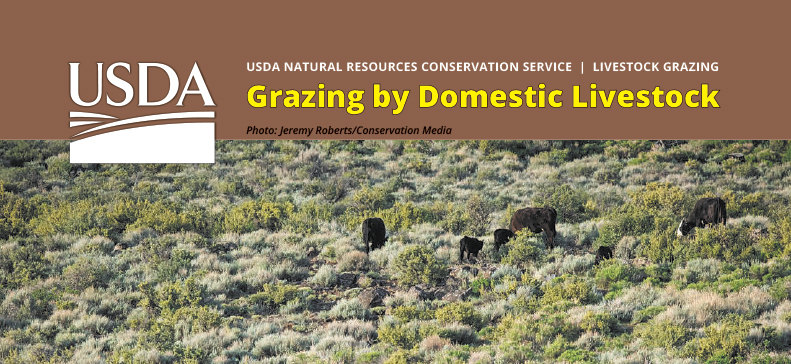
Working Lands for Wildlife’s (WLFW) shared vision of wildlife conservation through sustainable ranching includes producers as part of the solution for implementing conservation to reduce persistent, non–regulatory threats. This vision rallies and sustains partnerships from the start, sustaining landowner enrollment. Landowners are not forced to enroll. Instead, the WLFW shared vision is congruent with ranchers’ values and leverages the Farm Bill’s 80–year history of voluntary conservation to put that vision into practice.
WLFW use of coproduced science does not always yield anticipated outcomes, but forces conservationists to think differently about perceived threats. Such was the case when pastures rested from domestic grazing did not benefit sage grouse populations as originally hypothesized.1,2 Outcome assessments found no evidence that rest from grazing (≥12 months) increased daily nest survival rates. Rotational grazing systems and rest had negligible effects on herbaceous vegetation height and cover relative to other grazing strategies.1 Nest survival was comparable to range–wide averages, suggesting concealing cover for nests is unlikely to be limiting population growth regardless of grazing strategy. In response, the USDA’s Natural Resources Conservation Service (NRCS) adjusted the delivery of conservation practices to de–emphasize financial incentives for extended rest within rotational grazing systems.
Additional science revealed maximization of hiding cover may be overemphasized in grazing management guidelines and policies.1 Findings suggested females instead select nest sites based on relatively static features such as sagebrush cover and distance from roads, whereas nest failure was driven primarily by extended periods of heavy precipitation. As a result, the management of sage grouse nesting habitat should focus on conserving areas of adequate shrub cover and preventing fragmentation of intact grazing lands.
Entomological study in the same landscapes showed arthropods consumed by sage grouse were twice as prevalent in grazed shrublands than in nearby pastures that had been idled without domestic grazing for more than a decade.3 Lands managed with grazing supported a more diverse assemblage of ground–dwelling arthropods, which may be particularly beneficial as food resources for birds. Outcomes suggested that periodic disturbance may enhance arthropod diversity and that sage grouse may benefit from livestock grazing with periodic rest or deferment.
Findings spawned additional inquiry challenging the long–held belief that grazing restrictions inevitably benefit sage grouse populations.
A follow–up study revealed commonly used methodologies are inherently biased, misrepresenting the relationships between habitat structure and sage grouse nest success.4 A range–wide meta–analysis reveals weak effects of grass height on nest–site selection with no relationship to nest success, suggesting nesting habitat–fitness relationships have been inappropriately extrapolated in developing range–wide habitat management objectives.5
Management of public lands, and who should have access to them, remains contentious in the West. Most private ranching enterprises rely upon seasonal grazing access to public lands, and ongoing wildlife conflicts result in continual calls to restrict grazing on public lands. In a final line of questioning, WLFW found restricting grazing on public lands can increase habitat loss on private lands and reduce community support for conservation.6 A preferred approach for maintaining habitat is a policy that facilitates management on public lands while also supporting sustainable, economically viable ranching operations on private lands.
Click on graph images below to view larger:



WLFW–SUPPORTED SCIENCE PUBLICATIONS:
- Smith, J.T., J.D. Tack, L.I. Berkeley, M. Szczypinski, and D.E. Naugle. 2018. Effects of rotational grazing management on nesting greater sage–grouse. Journal of Wildlife Management 82:103–112.
- Smith, J.T., J.D. Tack, L.I. Berkeley, M. Szczypinski, and D.E. Naugle. Effects of livestock grazing on nesting sage grouse in central Montana. 2018. Journal of Wildlife Management 82:1503–1515.
- Goosey, H.B., J.T. Smith, K.M. O’Neill and
D. E. Naugle. 2019. Ground–dwelling arthropod community response to livestock grazing: Implications for avian conservation. Environmental Entomology 48:856–866. - Smith, J.T., J.D. Tack, K.E. Doherty, B.W. Allred,
J. D. Maestas, L.I. Berkeley, S.J. Dettenmaier, T.A. Messmer, and D.E. Naugle. 2018. Phenology largely explains taller grass at successful nests in greater sage–grouse. Ecology and Evolution 8:356–364. - Smith, J.T., B.W. Allred, C.S. Boyd, J.C. Carlson, K.W. Davies, C.A Hagen, D.E. Naugle, A.C. Olsen, and J.D. Tack. 2020. Are sage–grouse fine–scale specialists or shrub–steppe generalists? Journal of Wildlife Management 84:759–774.
- Runge, C.A., A.J. Plantinga, A.E. Larsen, D.E. Naugle, K.J. Helmstedt, S. Plasky. J.P. Donnelly, J.T. Smith, T.J. Lark, J.J. Lawler, S.M. Martinuzzi, and J. Fargoine. 2019. Unintended habitat loss on private land from grazing restrictions on public rangelands. Journal of Applied Ecology 56:52–62.
RELATED READINGS:
Runge, C.A., J.C. Withey, D.E. Naugle, J.E. Fargione, K.J. Helmstedt, A.E. Larsen, S. Martinuzzi, and J.D. Tack. 2019. Single species conservation as an umbrella for management of landscape threats. PLoS One 14:e0209619.
Dahlgren, D.K., R.T. Larsen, R. Danvir, G. Wilson, E.T. Thacker, T.A. Black, D.E. Naugle, J.W. Connelly, and T.A. Messmer. 2015. Greater sage–grouse and range management: Insights from a 25–year case study in Utah and Wyoming. Rangeland Ecology and Management 68:375–382.
Stevens, B.S., D.E. Naugle, B. Dennis, J.W. Connelly, T. Griffiths, and K.P. Reese. 2013. Mapping sage grouse collision risk: Spatially explicit models for targeting conservation implementation. Wildlife Society Bulletin 37:409–415.
Stevens, B.S., K.P. Reese, and J.W. Connelly. 2011. Survival and detectability bias of avian fence collision surveys in sagebrush steppe. Journal of Wildlife Management 75:437–449.
